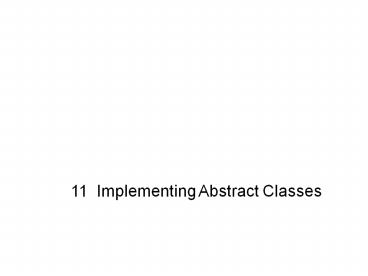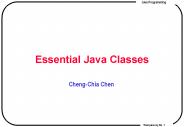11 Implementing Abstract Classes - PowerPoint PPT Presentation
Title:
11 Implementing Abstract Classes
Description:
Define an abstract class and its importance. Demonstrate how to ... A core reason for using interfaces is to be able to upcast to more than one base type ... – PowerPoint PPT presentation
Number of Views:143
Avg rating:3.0/5.0
Title: 11 Implementing Abstract Classes
1
11 Implementing Abstract Classes
2
Contents
- Define Abstract Class
- Rules on Abstract Class
- Define Interface
- Implementing Interface
- Uses of Interface
- Abstract class versus Interface
- Define Final Class
- Rules on Final Class
- Abstract class versus Final class
3
Objectives
- Define an abstract class and its importance
- Demonstrate how to declare an abstract class
- Define interface and its importance
- Demonstrate how to declare an interface
- Differentiate the use of abstract class and
interface - Define final class and its importance
- Demonstrate how to declare a final class
- Differentiate the use of abstract class and final
class
4
Defining Abstract Class
- An Abstract Class is a class that provides common
behavior across a set of subclasses, but is not
itself designed to have instances of its own - A class that dictates certain behavior but allows
its subclasses to provide implementation - A class designed only as a parent from which
sub-classes may be derived, but which is not
itself suitable for instantiation - A class often used to "abstract out" incomplete
sets of features which may then be shared by a
group of sibling sub-classes which add different
variations of the missing pieces
5
Rules on Abstract Class
- An Abstract Class cannot be instantiated
- An abstract class can SHOULD be extended
- An abstract class can have any number of abstract
methods or none at all - A class with at least one abstract method must be
declared an abstract class - A subclass can provide partial or full
implementations of the inherited abstract methods - A class that has at least one abstract method,
whether declared or inherited from an abstract
class, must be declared abstract.
6
Abstract Class (Example)
- public abstract class AccountInfo
- private String acctNo
- private String acctName
- private double balance
- public String getAcctNo() return acctNo
- public void setAcctNo(String no) acctNo no
- public String getAcctName() return acctName
- public void setAcctName(String name)acctName
name - public double getBalance() return balance
- public void setBalance(double bal) balance
bal - public abstract void printAccountInfo()
- public class Savings extends AccountInfo
- public void printAccountInfo()
- System.out.println("Account Number "
getAcctNo()) - System.out.println("Account Name "
getAcctName()) - System.out.println("Account Balance "
getBalance())
public class BankApp public static void
main(String args) Savings pesoAcct new
Savings() pesoAcct.setAcctNo("001")
pesoAcct.setAcctName("Juan dela Cruz")
pesoAcct.setBalance(500) pesoAcct.printAccoun
tInfo()
Account Number 001 Account Name Juan dela
Cruz Account Balance 500.0
7
Defining Interface
- An Interface defines a contract by specifying a
set of method prototypes for which each class
that implements it must adhere - An interface is 100 abstract class
- An interface provides only a form for a class but
no implementation - An interface defines what a class can do but not
how the class will do it
8
Implementing Interface
- Implementing an interface means providing
implementations for its methods - Interfaces are implemented using the implements
keyword - Rules on implementing the interface methods
- Must have the same method signature and return
type - Cannot narrow the method accessibility
- Cannot specify broader checked exceptions
- Interface variables are implicitly public final
static - Interface methods are implicitly public abstract
9
Rules on Interface
- An interface can extend several interfaces
- Interfaces can be implemented by any class
- A class can implement several interfaces, thus
enabling multiple inheritances - A class that implements an interface partially
must be declared abstract - An interface can be declared as a reference
variable - An interface cannot implement any data type
- An interface cannot be instantiated
10
Interface (Example)
public class BankApp public static void
main(String args) Savings pesoAcct new
Savings() pesoAcct.setAcctNo("001")
pesoAcct.setAcctName("Juan dela Cruz")
pesoAcct.setBalance(500) pesoAcct.printAccoun
tInfo() pesoAcct.deposit(300)
pesoAcct.withdraw(50) System.out.println("Upd
ated Balance " pesoAcct.balanceInquiry())
- public abstract class AccountInfo
- /
- class body here (from Abstract Class example)
- /
- public interface BankOperations
- public void withdraw(double amount)
- public void deposit(double amount)
- public double balanceInquiry()
- public class Savings extends AccountInfo
implements BankOperations - public void printAccountInfo()
- System.out.println("Account Number "
getAcctNo()) - System.out.println("Account Name "
getAcctName()) - System.out.println("Account Balance "
getBalance()) - public void withdraw(double Amount)
Account Number 001 Account Name Juan dela
Cruz Account Balance 500.0 Updated Balance 750.0
11
Uses of InterfaceMultiple Inheritance
- A core reason for using interfaces is to be able
to upcast to more than one base type - Several interfaces can be implemented by any
class, thus resulting in multiple inheritance
- interface CanFight void fight()
- interface CanSwim void swim()
- interface CanJump void jump()
- class ActionStar implements CanFight
- public void fight()
- //fight here
- class Hero extends ActionStar implements CanSwim,
CanJump - public void swim()
- //swim here
- public void jump()
- //jump here
12
Uses of InterfaceDefining Constants
- An interface is a convenient place for defining
constant values
- interface DateConstants
- int JANUARY 1
- int FEBRUARY 2
- int MARCH 3
- int APRIL 4
- int MAY 5
- int JUNE 6
- int JULY 7
- int AUGUST 8
- int SEPTEMBER 9
- int OCTOBER 10
- int NOVEMBER 11
- int DECEMBER 12
- class BirthDay implements DateConstants
- boolean isMyBirthday(int mm, int dd, int yy)
- if (mm APRIL dd20 yy1980) return
true - return false
13
Abstract Class vs Interface
- Considerations in using either an interface or
abstract class - An interface is useful because any class can
implement it. But an interface, compared to an
abstract class, is a pure API specification and
contains no implementation. - If another method is added in an interface, all
classes that implemented that interface will be
broken - A good implementation of both is to create an
interface and let the abstract class implement
it. So when there is a need for adding methods,
it can be safely added to the abstract class
itself rather than the interface. - Use interfaces when a certain method needs to be
forcibly overriden/enforced by a class.
14
Defining Final Class
- A Final Class is considered complete, it cannot
be improved or specialized - A final class ensures that its state and behavior
cannot be changed for safety and security - To re-use a final class, you must utilize
composition instead of inheritance
15
Rules on Final Class
- A final class cannot be extended or subclassed
- All methods of a final class have implementations
- All methods of a final class are implicitly final
- Members of the final class cannot be inherited or
hidden - Methods of the final class cannot be overridden
16
Final Class (Example)
- final class Formula
- static double speed(double distance, double
time) return distance/time - static double acceleration(double s2, double s1,
double t) return (s2-s1)/t - static double force(double mass, double acc)
return mass acc - static double pressure(double force, double
area) return force / area - static double work(double force, double
distance) return force distance - public static void main(String args)
- double d1 50, t1 10
- double d2 80, t2 10
- double mass 50
- double s1 Formula.speed(d1, t1)
- double s2 Formula.speed(d2, t2)
- double acc Formula.acceleration(s2, s1, 60)
- double force Formula.force(mass, acc)
- double pressure Formula.work(force,10)
If I weigh 50.0 kg, and my initial speed is 5.0
m/s, and my final speed is 8.0 m/s. Then, my
acceleration in 1 minute is 0.05 m/s2, and I'm
exerting a force of 2.5 newton, and a pressure
of 25.0 joules for 10 meters! ehem -)
17
Abstract Class vs Final Class
- Abstract class provides a template of behaviors
for subclasses to follow without actually
dictating to the subclasses the exact
implementation of those behaviors. - Final class, since it cannot be extended,
encourages composition, while abstract class
encourages inheritance. - Inheritance, through abstract classes, introduces
tight coupling between classes and can weaken
encapsulation by deferring actual implementation
to subclasses. - Final classes are used to prevent malicious code
from altering the semantics of classes essential
to a framework.
18
Key Points
- An Abstract Class is a template with at least
partial implementation that other subclasses are
supposed to follow. They are not by themselves
suitable for instantiation. - An Interface defines a contract by specifying a
set of abstract method prototypes without
actually specifying the implementation. - Interfaces are implemented using the implements
keyword. - Interfaces are used to implement multiple
inheritances. - A Final Class is considered complete it cannot
be extended.































